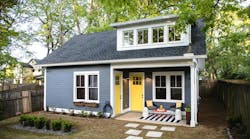See the Light
Good lighting design makes workstations in the home more usable and relaxation areas more comfortable.
"One lighting system can’t do it all," lighting consultant Nancy Clanton says. "Each room needs lighting design that is appropriate for the space.
"Too often homes are filled with recessed cans in the ceiling that only create pools of light on the floor. Downlights don’t create light where you need it. When we design lighting for new homes, the first thing we do is take out the cans everywhere but over the kitchen sink. Instead, we encourage indirect lighting using a cove or valance to indirectly light the ceiling. We then add different types of lighting depending on how each room will be lived in."
There are three general types of lighting. Ambient lighting is generally indirect and in the background. Accent lighting is used to create character or mood in a room and often focuses on art, furniture or plants. Task lighting is used for specific activities. Isolate task lighting where it is needed: downlights in the laundry, lamps for reading, recessed cans for cooking prep in the kitchen, or floodlights in hobby rooms.
Light the ceiling and walls, not the floor, to give rooms a sense of space. You need a balance - natural lighting and electric lighting, uplight and wall sconces, a pendant and decorative lighting for brightness on accents. Put everything on dimmers. Make sure the light can be balanced per the occasion. For parties, everything is on. Candlelit dinners need different accents.
There are different ways to achieve good lighting in each room:
Kitchen
A combination of ambient and task lighting adds dimension and interest to the kitchen. Photo: SylvaniaEliminate the valance over the cabinets, and atop the cabinets install fluorescents aimed at the ceiling for indirect lighting. Use under-counter lights for task lighting. People use them and love them, and they give extra punch to a kitchen. Over the sink is the only place to use downlighting.
Bathroom
Put a valence over the mirror with compact fluorescent lights (CFLs). Have uplighting 6 inches from the ceiling. If that’s not possible, use wall sconces on either side of the mirror. They cast a soft glow on faces. Don’t use Hollywood exposed bulbs around the mirror. They are too harsh. Soften the light with dimmers to improve the effect.
Living room
In dining rooms, indirect, direct and accent lighting provide plenty of illumination while setting an intimate mood. Photo: Philips.Use wall sconces in living rooms as well as hallways and dining rooms. The soft lighting creates an effect like candlelight. Use track lighting for highlighting wall art or photos. In rooms with tall ceilings, use compact fluorescent track lighting. Track lighting should be mounted 2 feet from the wall and aimed at the wall art. More accent lighting creates a cozy, warmer feeling.
Compact fluorescent torchier lighting for living rooms is gaining popularity and is especially good for low ceilings. Many torchier lights are available with dimmers. Don’t use tungsten/halogen bulbs, which can cause fires and might cost as much as $100 a year to operate.
Dining room
Over the center of the table, hang a chandelier that is at least 1 foot smaller than the smallest dimension of the table. Wash the wall decorations with track lights on the ceiling with separate dimmers. Use accent lighting on plants or special furniture to change the focus of the room.
Bedroom
Even rooms with plenty of natural light can benefit from task lighting, such as the recessed can that provides reading light in this bedroom. Photo: Philips.Bedrooms typically have switched outlets. This encourages table lamps with incandescent bulbs. Never use overhead ceiling fixtures in bedrooms. Instead, use two wall sconces on dimmers to provide soft light and bright light when appropriate. Create different lighting zones so the mood can be adjusted.
Energy-efficient lighting
Using natural daylight or day lighting is a first step in improving the feel of a home while reducing energy costs. Make sure every room has day lighting. When it is done well, no electric lights need to be on during the day. If that is not possible, make sure lights are dimmable during the day so they balance the daylight. When you lack day lighting, you might need only task lighting, not uplights or downlights.
"The primary benefit of day lighting is the connection with the outdoors," Clanton says. "It relaxes our eyes and improves creativity. Sleep patterns of elderly people are different when they live with good day lighting. With high exposures during the day, they sleep better at night."
Clanton Engineering designs energy-efficient lighting for homes and other buildings all over the world. According to the Environmental Protection Agency’s Green Lights Program, lighting accounts for 20% to 30% of the electricity used annually in the United States. In some homes this percentage can be as high as 50%.
Technological advances in lamps, luminaries and ballasts have enabled dramatic reductions in the amount of energy used to light a home. CFLs have improved much during the past few years, with increases in the diversity of types and the range of temperatures (color of light). A typical incandescent bulb is a 3,000-degree Kelvin lamp. Old fluorescent tubes are 4,000 degrees K.
Dimming CFLs are now affordable. They must have a dimming ballast to work with wall dimmers made for fluorescents. The color of the bulb is the number next to the wattage of the bulb: 30K means 3,000 degrees Kelvin, and 27K, 30K, 35K and 40K are typical for CFL lamps. Redder bulbs are lower (27K), bluer bulbs are higher (40K or cool white). Commercial sources use 70, 80 or 90 color rendering index, or how colors look under this light source; 80 and above is best for homes. Usually this information is available from a lighting supply store.
Saving watts and dollars
|
||||||||||||||||||||||||||||||||||||||||||

